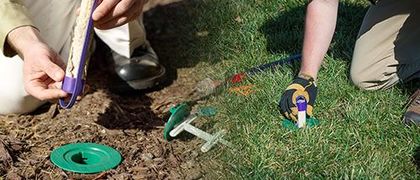What do lone star ticks look like?
- Size: 1/6 - 1/2 in.
- Color: Solid brown; females possess a white star-like dot in the middle of their backs
- Body Structure: Flat body with eight legs

Characteristics of lone star ticks
Like other ticks, the lone star tick is parasitic and requires blood of a host animal to reproduce. Female adults will gorge themselves with a host’s blood before dropping to the ground and depositing clusters of thousands of eggs. Males, who may mate with several females, die after mating. Likewise, females die after they have laid their eggs. When eggs hatch they release larva, which often are referred to as “seed ticks.” Seed ticks, which feature just 6 legs at this point, immediately seek a host upon which to feed. After feeding on the host, the seed tick will fall to the ground, molt and emerge as a nymph with 8 legs. The nymph repeats this process, and finally emerges as an adult. The entire life cycle may take up to 3 years to complete.
When are lone star ticks most active?
Where are lone star ticks found?
Lone star ticks live in wooded environments as they cannot survive long exposure to the sun. Transitional areas where woods meet lawn are a favorite habitat for these ticks.
Generally speaking, lone star ticks do not live long inside homes. If they're found inside, it's likely they were attached to a pet and brought in.
What do lone star ticks eat?
Lone star ticks must eat blood (human or other mammals) at every life stage in order to survive and reproduce. They do not eat other insects, plant nectar, or anything other than blood.
Are lone star ticks dangerous?
Lone star ticks should be considered a threat to people and pets as they are capable of transmitting tularemia, Heartland virus, STARI (or southern tick-associated rash illness), and two bacteria that cause ehrlichiosis.
Why do I have a lone star tick infestation?
As noted above, lone star ticks feed on blood of people but also mammals, such as deer, dogs, squirrels, and even birds so if your property has plenty of animal activity, there's a good chance they were attracted to it. If your property has plenty of woods and shaded areas, it may be a perfect habitat for lone star ticks.
How do I get rid of lone star ticks?
If you are concerned about lone star ticks around your home, please consult a pest control professional. At Miller Pest & Termite, we offer effective pest control solutions and would like the opportunity to help you eliminate your tick problem. Reach out today for more information!
How can I prevent an American dog tick problem?
To make your property less appealing to American dog ticks, we recommend:
- Keeping your grass cut short
- Eliminating rodent harborages (and rodents)
- Remove weeds and overgrown vegetation
- Discourage wildlife by installing fence and removing potential food sources


Get Help Now!












